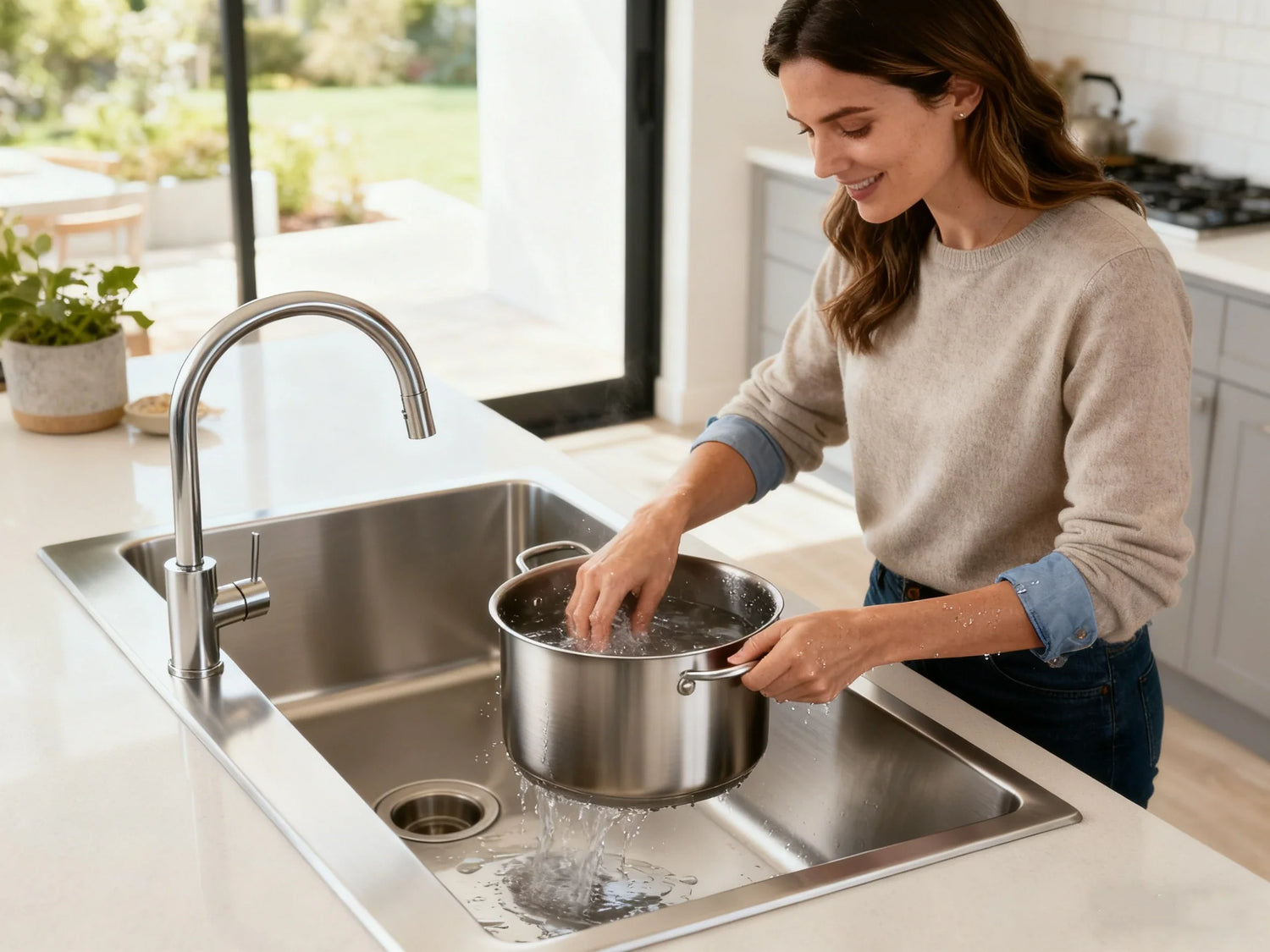Quick answers: the best stainless steel sink for you
- Best all‑around: a 16‑gauge, 304 stainless steel undermount with sound‑dampening pads if you cook often or use heavy cookware.
- Value choice for most homes: an 18‑gauge, 304 stainless sink with pads and undercoating.
- Avoid thinner than 18‑gauge for the main kitchen sink. Thinner steel (20–23 gauge) is louder and dents more easily. It belongs in light‑duty or utility spaces.
Noise and durability at a glance

Visual/Interactive: One‑minute sink picker flowchart
Cook daily with heavy pots or cast iron?
Yes: pick 16‑gauge 304 with full‑coverage pads.
No: pick 18‑gauge 304 with pads.
Countertop type and mount:
Stone/solid surface: undermount for a clean edge.
Laminate/wood: drop‑in (top‑mount) to protect the edge.
Space and layout:
30–33" cabinet: single bowl 30–32" or tight‑radius 32–33".
36" cabinet: 32–36" single or 33" double bowl.
Workflow:
Want extra prep space? Choose a workstation sink with ledge accessories.
Budget:
Under $200: 18‑gauge entry models (look for pads).
$250–$600+: 16‑gauge, better sound control, ledges, and accessories.
Gauge, grade, and noise performance
Gauge explained: lower number = thicker
- 16‑gauge is about 0.0625 inches (≈1.59 mm).
- 18‑gauge is about 0.05–0.055 inches (≈1.27–1.40 mm).
- 20+ gauge is thinner than 0.05 inches and is more prone to flex and noise.
304 stainless steel (18/8 or 18/10): corrosion resistance, finish, food‑safe quality
Sound control: gauge vs undercoating/pads
- Thickness (gauge): Thicker bowls vibrate less when water hits or pans clink.
- Sound treatment: Dense pads and spray‑on undercoating under the bowls absorb vibration. Full‑coverage pads (not just at the corners) do the best job. If noise is your top complaint with your current sink, choose a thicker gauge with full pads.
Case snapshots
Sink types, configurations, and must‑have features
Types
- Undermount sink: attaches under the countertop so the counter edge sits flush over the bowl. People also call these underslung kitchen sinks. They make wiping crumbs into the bowl easy and look seamless with stone or solid surfaces.
- Drop‑in or top‑mount sink: rests on the counter with a rim. It works well with laminate or wood because the rim protects the cut edge.
- Farmhouse/apron‑front sink: has an exposed front that replaces part of the cabinet face. It offers great bowl space and a classic look but needs strong cabinet support.
- Workstation sink: adds ledges and accessories like cutting boards and colanders that slide along tracks, turning the sink into a mini prep zone.

Bowls and size
- Common kitchen sink sizes: 27–36 inches wide overall for the main sink, with 30–33 inches being the sweet spot. A 36" base cabinet can often handle a 33–36" sink.
- Typical depth: 9–10 inches. Deeper bowls hold more but can strain your back if you're shorter or if you mount the sink low in a thick countertop.
- Corner radius: R0 (zero‑radius) means sharp, squared corners and a modern look; R10 (or larger) has softer, rounded corners that are easier to wipe clean.
Finishes and coatings
- A matte etched look can further reduce glare and fingerprints.
- Mirror polish looks sleek but shows scratches fast in a working kitchen.
- Some sinks use PVD (a physical vapor deposit color layer) to create black, gunmetal, or brass‑tone hues.
- Colored stainless can match modern hardware but needs gentle care to protect the coating.
Must‑haves: grids, strainers, drain position, slope, accessories
- A bottom grid protects the bowl from pots and helps water drain under dishes.
- A good strainer catches food and seals when needed.
- Rear drains open up space under the sink for trash bins or pull‑outs and improve drain flow when dishes sit on a grid.
- A slight slope toward the drain reduces puddles.
Visuals: Comparison table
| Sink Type | Best For | Pros | Watch-outs |
|---|---|---|---|
| Undermount (underslung) | Stone/solid surfaces | Clean wipe-in edge; seamless look | Needs precise cutout; support clips/rails; seal carefully |
| Drop-in (top-mount) | Laminate/wood tops | Easy install; rim protects cut edge | Rim catches crumbs; visible caulk line |
| Farmhouse/apron-front | Style + large bowl area | Big capacity; iconic look | Cabinet and front support needed; heavier |
| Workstation (with ledge) | Small kitchens; heavy prep | Adds prep + drying space; efficient | Accessories add cost; measure ledge clearance with faucet |
Installation and replacement (DIY vs pro)
Prep checklist
- Measure the base cabinet and confirm the sink's minimum cabinet width.
- Check the kitchen sink sizes dimensions: overall, cutout, inside bowl, and depth.
- Confirm mounting type: undermount needs a clean, polished counter edge; drop‑in needs a flat surface for the rim.
- For apron‑front, plan for a support frame or rails beneath the front edge.
- Map the drain to existing plumbing; rear drains may need a simple trap relocation.
- Dry‑fit the faucet, sprayer, soap dispenser, and any accessories.
- Gather silicone for sealing, clips/brackets, rails, shims, and a level.
- If replacing, remove the old sink and clean the opening; scrape away old sealant.
Step‑by‑step overview
- Dry‑fit the sink in the opening and check level front‑to‑back and side‑to‑side.
- Apply a continuous bead of high‑quality, kitchen‑grade silicone to the flange or rim.
- Set the sink, align the reveal (for undermount, choose flush/positive/negative reveal).
- Install clips, brackets, or mounting rails and tighten evenly to avoid twist.
- Wipe away squeeze‑out and smooth the sealant line.
- Attach drain, basket strainer, and plumber's putty where specified.
- Reconnect plumbing; check for leaks.
- Let sealant cure as directed before heavy use, usually 12–24 hours.
Visuals & Tools: Install diagram, tool list, timeline; calculator for DIY vs pro costs/time
- Basic tools: drill/driver, silicone gun, putty knife, level, clamps, adjustable wrench, plumber's putty, bucket, towels.
- Typical timeline: 3–5 hours for a replacement undermount or drop‑in; a full kitchen rework can take longer due to countertop and plumbing.
| Path | Typical Cost | Time | Notes |
| DIY replacement (undermount/drop‑in) | $0–$100 supplies | 3–5 hrs | Good if cutout fits and plumbing lines up |
| Pro install (labor only) | $200–$500+ | 2–4 hrs | Add more for plumbing moves or apron support |
| Countertop fab (new undermount) | Varies by shop | Same day as counter | Often includes sink cutout, polish, and rail setup |
Costs, warranties, and sustainability
Price benchmarks
| Gauge | Typical Price Range | What You Get |
| 16‑gauge | $250–$600+ | Thicker bowls, better sound pads, workstation ledge options |
| 18‑gauge | $120–$350 | Solid everyday sinks, good value, often with pads |
| 20–23 gauge | $60–$150 | Budget/utility use; louder and more dent‑prone |
Total cost of ownership
| Item | Typical One‑Time Cost | 10‑Year Notes |
| Sink (16g) | $250–$600+ | Long lifespan; better noise |
| Sink (18g) | $120–$350 | Great value; still durable |
| Faucet + sprayer | $100–$600+ | Moving parts; may replace once |
| Accessories (grid/boards) | $30–$200+ | Grids save the bowl; boards boost workflow |
| Pro install | $200–$500+ | Worth it for apron‑front or plumbing shifts |
| Cleaning supplies | $20–$40/yr | Mild cleaners; microfiber towels |
Warranties and certifications
- NSF/ANSI certifications related to food equipment materials and sanitation used by some commercial‑style products.
- UPC listing for plumbing product compliance in the U.S. and Canada.
- Compliance with ASTM standards for stainless sheet quality (for 304 grade).
- "Lead‑free" claims apply more to faucets, but it's still wise to check certifications for everything you mount on the sink.
Eco profile
Care, cleaning, and common fixes
Daily/weekly routines
- Rinse after use, wipe with a soft sponge and mild dish soap, then dry with a microfiber towel to cut water spots.
- For weekly care, use a gentle stainless cleaner or baking soda paste.
- Avoid steel wool, harsh scouring powders, and chlorine bleach. They can scratch or damage the protective layer that keeps your sink stainless.

Water spots, tea stains, surface rust
- To remove them, try a 50/50 mix of water and white vinegar, then rinse and dry.
- For stubborn spots, a sink‑safe powder cleaner can help. Rinse well and wipe dry to prevent new spots.
- If you see light surface "rust," it's usually free iron from tools or cookware that transferred to the surface. A non‑abrasive stainless cleaner or a mild acid wipe (like diluted vinegar) clears it, followed by a water rinse and dry.
Scratch repair and dent prevention
- Fine scratches blend over time with normal use, especially on brushed or satin finishes.
- To speed this up, use a fine non‑woven pad or specialty stainless pad, moving with the metal's grain.
- To prevent dents, use a bottom grid and avoid dropping heavy pans. This is where 16‑gauge pays off, especially under cast iron.
Design trends and kitchen integration
Pairing with countertops
- For stone or solid surfaces like quartz or granite, undermount stainless steel gives the cleanest edge and easy wipe‑in action.
- For laminate, a drop‑in rim protects the cut edge.
- Coordinate the sink finish with your faucet and pulls.
- Brushed or satin sinks pair well with brushed nickel or stainless faucets.
- If you choose a colored PVD sink, echo that tone in a few cabinet handles or a faucet accent for a cohesive look.
Modern looks
- Sharp, zero‑radius (R0) corners look modern and maximize flat bottom area for pans.
- Rounded corners (R10 or higher) soften the look and are easier to clean with a sponge.
- Matte/brushed finishes hide wear better than mirror polish.
- If you want a bolder statement, black or gunmetal stainless is trending, especially with warm wood and light counters. Just be gentle with cleaning to protect the color layer.

Workstation sinks
Conclusion and key takeaways
- Pick the right gauge for your use
- Choose 304 stainless steel
- Make sure the sink has sound‑dampening pads and good undercoating
Decision checklist
- Cabinet size and cutout; confirm the sink's inside bowl space and depth
- Mount type: undermount for stone; drop‑in for laminate
- Gauge: 16 for heavy use; 18 for most homes; avoid 20–23 for main sinks
- Grade: prefer 304 stainless for corrosion resistance
- Noise control: full‑coverage pads and undercoating
- Finish: brushed/satin for scratch hiding; matte for low glare
- Extras: bottom grid, rear drain, workstation ledge if you prep often
- Budget: balance sink price with faucet, install, and accessories
FAQs
1. Is 16‑gauge worth it over 18‑gauge?
2. Rear drain or center drain—which drains better?
- Center drains are the traditional choice, guiding water straight to the middle for easy dishwashing.
- Rear drains, however, are popular in modern kitchens because they free up space. With the drain at the back, large pans can sit flat without blocking it, and plumbing is tucked against the wall, leaving more room in the cabinet for bins or pull-outs.








Leave a comment
This site is protected by hCaptcha and the hCaptcha Privacy Policy and Terms of Service apply.